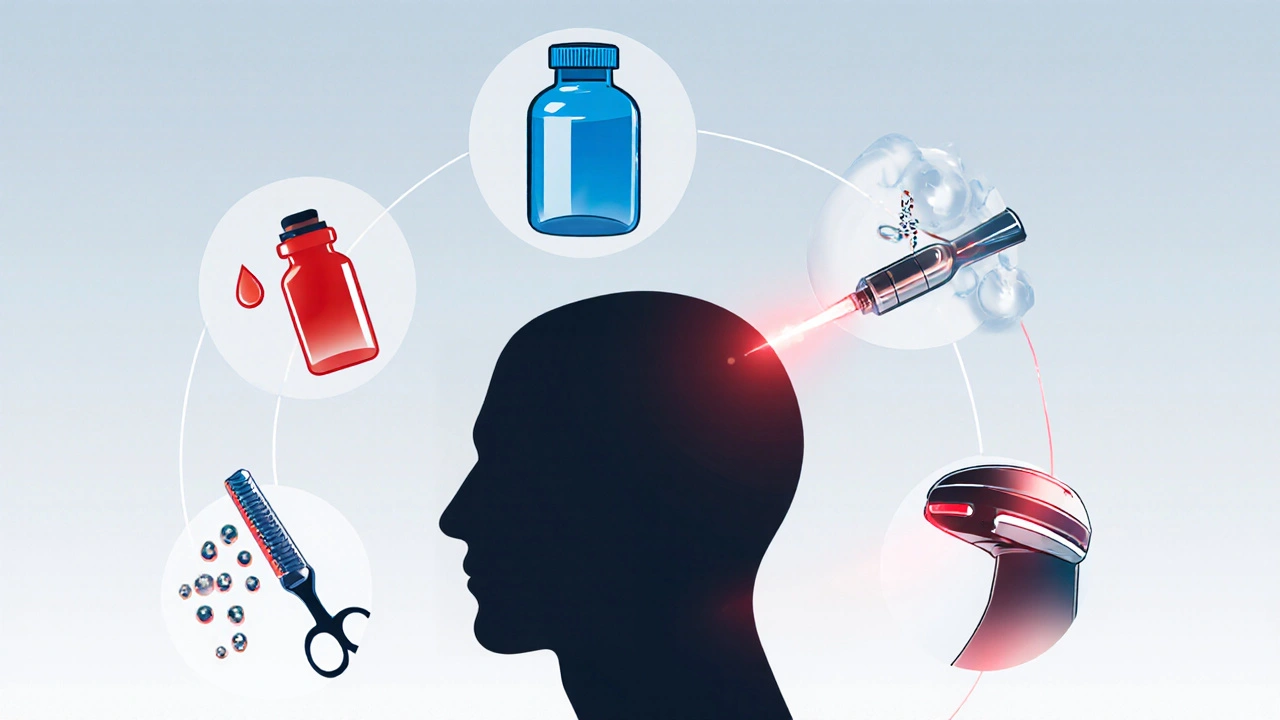 Oct, 5 2025
Oct, 5 2025
Hair Loss Treatment Decision Matrix
Rate each criterion from 1 (least important) to 5 (most important) to find your ideal treatment.
Effectiveness
Does the treatment halt loss, regrow, or both?
Side Effects
Are you comfortable with potential irritation, sexual dysfunction, or surgical risks?
Cost
Upfront price vs. long-term maintenance expense.
Convenience
Daily application, monthly visits, or one-time surgery?
Suitability
Male vs. female, early-stage vs. advanced thinning, scalp condition.
Recommended Treatment
When you're trying to figure out the best hair loss treatment is a medical or cosmetic approach aimed at slowing, stopping, or reversing hair thinning and balding, the sheer number of options can feel overwhelming. This guide breaks down the science, the costs, and the real‑world pros and cons so you can match a solution to your own hair goals, budget, and lifestyle.
Key Takeaways
- Identify the cause of your hair loss (genetics, hormones, stress, or nutrition) before picking a product.
- Topical minoxidil works for most early‑stage patterns, while oral finasteride targets hormonal drivers.
- Surgical options like hair transplant provide permanent density but require higher investment.
- Emerging therapies such as platelet‑rich plasma (PRP) and low‑level laser therapy (LLLT) suit people looking for non‑drug alternatives.
- Create a decision checklist based on effectiveness, side‑effects, cost, and maintenance effort.
What Triggers Hair Loss?
Understanding the root cause helps you avoid wasted money. The most common driver is DHT (dihydrotestosterone, a hormone that shrinks hair follicles). Genetics decide how sensitive your follicles are to DHT, but other factors like chronic stress, poor scalp health, and nutrient deficiencies can accelerate the process. Alopecia alopecia (the medical term for hair loss, covering patterns like androgenic alopecia and alopecia areata) isn’t always hormonal; autoimmune attacks, medication side‑effects, or thyroid imbalances can also play a role.

Major Categories of Hair Loss Treatments
Broadly, treatments fall into four buckets:
- Topical solutions - most people start with minoxidil.
- Oral medications - finasteride is the go‑to for men and low‑dose oral minoxidil for some women.
- Surgical or procedural - hair transplant, PRP, and LLLT.
- Lifestyle & scalp care - diet, stress management, and regular scalp massage.
Minoxidil
Minoxidil (a topical vasodilator available in 2% and 5% strengths) was originally a blood‑pressure drug, but researchers found it could stimulate hair follicles. It’s FDA‑approved for both men and women. Typical results appear after 3-6 months of twice‑daily use. Side‑effects are mild: scalp irritation, temporary shedding, or rare allergic reactions.
Finasteride
Finasteride (an oral 5‑alpha‑reductase inhibitor taken at 1mg daily for hair loss) blocks the conversion of testosterone into DHT, addressing the hormonal root. Clinical trials show a 90% reduction in hair‑loss progression and noticeable regrowth in many users. Men must stay on the medication continuously; women, especially of child‑bearing age, should avoid it due to birth‑defect risk.
Hair Transplant
Hair transplant (a surgical procedure that moves healthy follicles from donor sites to balding areas) offers permanent restoration. Two main techniques dominate: Follicular Unit Extraction (FUE) and Follicular Unit Transplantation (FUT). Success rates exceed 95% when performed by experienced surgeons, but the cost ranges from $4,000 to $15,000 depending on graft count and geography.
Platelet‑Rich Plasma (PRP)
Platelet‑rich plasma (an injectable concentrate of a patient’s own platelets that releases growth factors to stimulate follicles) is a non‑drug alternative gaining popularity. Typical protocols involve three monthly sessions followed by maintenance every 4-6 months. Studies report a 30-40% increase in hair density for responsive patients, with minimal downtime.
Low‑Level Laser Therapy (LLLT)
Low‑level laser therapy (red‑light devices that boost cellular metabolism in hair follicles) can be used at home via helmets, combs, or caps. A daily 15‑minute session over six months may thicken existing hair by 10‑15%. It’s painless, drug‑free, but results vary widely.
Decision Criteria: How to Pick the Best Option
Before you click “add to cart,” rank each factor on a scale of 1‑5 for your situation.
- Effectiveness - Does the treatment halt loss, regrow, or both?
- Side‑effects - Are you comfortable with potential irritation, sexual dysfunction, or surgical risks?
- Cost - Upfront price vs. long‑term maintenance expense.
- Convenience - Daily application, monthly visits, or one‑time surgery?
- Suitability - Male vs. female, early‑stage vs. advanced thinning, scalp condition.
Answering these questions creates a personalized matrix that points you toward the most realistic solution.
Side‑by‑Side Comparison
| Treatment | Mechanism | Typical Cost (USD) | Effectiveness | Side‑effects | Best For |
|---|---|---|---|---|---|
| Minoxidil | Topical vasodilation & follicle stimulation | $30‑$60/month | 30‑40% hair‑density gain | Scalp irritation, initial shedding | Early‑stage thinning, women preferring non‑oral |
| Finasteride | DHT suppression | $10‑$20/month | 70‑90% halt of loss, 30% regrowth | Sexual dysfunction, rare depression | Male pattern baldness, moderate‑to‑severe loss |
| Hair transplant | Surgical relocation of follicles | $4,000‑$15,000 (one‑time) | Permanent, natural‑looking density | Surgical pain, scarring, infection risk | Advanced balding, stable donor area |
| PRP | Growth‑factor injection | $500‑$1,500 (initial series) | 30‑40% density increase | Minor bruising, discomfort | Those seeking non‑drug, moderate loss |
| LLLT | Red‑light stimulation of follicles | $200‑$1,200 (device) | 10‑15% thickness boost | None reported | Low‑risk maintenance, early to moderate loss |

Step‑by‑Step: Find Your Ideal Treatment
- Assess the pattern. Use the Norwood (men) or Ludwig (women) scale to gauge severity.
- Check underlying factors. Get a blood panel for thyroid, iron, and hormone levels. Address scalp conditions like psoriasis before starting any product.
- Set a budget. Decide if you prefer a low‑monthly spend (minoxidil) or a one‑time investment (transplant).
- Match criteria. Plug your scores for effectiveness, side‑effects, convenience, and suitability into the matrix above.
- Trial low‑risk options. Start with minoxidil or LLLT for 3‑4 months to see if you respond before escalating.
- Consult a specialist. A dermatologist or trichologist can confirm diagnosis, prescribe finasteride, or refer you to a certified surgeon.
- Commit to maintenance. Even surgical solutions need occasional PRP or medication to preserve results.
Common Pitfalls & Pro Tips
Pitfall: Switching products every few weeks hoping for a miracle. Tip: Give each treatment at least 3‑6 months to show results, unless serious side‑effects appear.
Pitfall: Ignoring scalp health. Tip: Use a gentle sulfate‑free shampoo, keep the scalp clean, and consider a weekly scalp massage to improve circulation.
Pitfall: Over‑relying on “miracle” supplements. Tip: Focus on proven agents (minoxidil, finasteride) and ensure you have adequate iron, vitaminD, and biotin levels.
Frequently Asked Questions
Can women use finasteride?
Finasteride is FDA‑approved only for men. Some clinicians prescribe a low dose off‑label for post‑menopausal women, but pregnancy risk makes it unsuitable for women of child‑bearing age.
How long does a hair transplant result last?
Transplanted follicles are taken from a permanent donor area, so they continue to grow for a lifetime. However, native hairs may still thin, so some patients maintain medication afterward.
Is PRP safe for everyone?
PRP uses your own blood, so allergic reactions are rare. People with blood disorders, active infections, or on anticoagulants should discuss risks with their doctor first.
Do I need a prescription for minoxidil?
Minoxidil is available over‑the‑counter in most countries. Higher‑strength (10%) formulas may require a doctor’s advice.
What lifestyle changes help keep hair healthy?
Maintain a balanced diet rich in protein, iron, zinc, and omega‑3 fatty acids; manage stress through exercise or meditation; avoid tight hairstyles that pull on follicles; and limit heat styling.

Michael Coakley
October 5, 2025 AT 14:30Oh great, another 5‑step matrix to tell us we need more money for our bald heads.
ADETUNJI ADEPOJU
October 6, 2025 AT 12:43While the decision matrix appears methodologically sound, the underlying pathophysiological assumptions regarding androgenic alopecia remain oversimplified. The matrix fails to incorporate a nuanced view of iatrogenic contributors, such as systemic medications or nutritional deficiencies. Moreover, the ethical implications of promoting costly interventions without robust longitudinal data are questionable. One must consider the socioeconomic disparities that such a model may exacerbate. Indeed, the moral responsibility of clinicians to prioritize evidence-based, accessible care cannot be ignored.
Janae Johnson
October 7, 2025 AT 10:57In a meticulously curated discourse, one might posit that the predominant reliance on pharmacological monotherapy insufficiently addresses the multifactorial etiology of alopecia. While minoxidil and finasteride dominate clinical practice, the omission of psychosocial stressors and scalp microenvironment warrants further scrutiny. It is prudent to challenge the prevailing orthodoxy, lest we inadvertently marginalize alternative modalities that could synergistically augment therapeutic outcomes. Nevertheless, empirical rigor must remain the cornerstone of any recommendation.
Kayla Charles
October 8, 2025 AT 09:10Thank you all for sharing such detailed perspectives; it's heartening to see a community so invested in unraveling the complexities of hair restoration.
When we talk about choosing a treatment, the first pillar is a realistic assessment of one's individual goals and constraints.
Many people underestimate how pivotal a thorough scalp examination and blood work panel can be in tailoring the optimal approach.
For instance, confirming iron levels, thyroid function, and vitamin D status can unmask reversible contributors that might respond to supplementation alone.
Beyond labs, lifestyle factors such as sleep hygiene, stress management, and nutrition play a non‑trivial role in follicular health.
If a client is hesitant about systemic medications, low‑level laser therapy offers a drug‑free adjunct that, while modest in efficacy, carries virtually no risk.
Conversely, for those with advanced Norwood V or VII patterns, discussing the long‑term cost‑benefit analysis of a hair transplant is essential.
Transplants, when performed by a board‑certified surgeon, can yield permanent results, yet they demand a substantial upfront investment and postoperative care.
Moreover, patients should be forewarned that even after a successful transplant, maintenance with finasteride or minoxidil may be advisable to protect native hairs.
The matrix presented in the guide is useful as a starting framework, but it should be supplemented with a personalized checklist.
I encourage readers to draft a table that ranks effectiveness, side‑effects, cost, convenience, and suitability according to their unique circumstances.
This exercise often reveals surprising priorities-for example, some individuals may value convenience over marginal efficacy gains.
Sharing experiences in supportive forums can also illuminate real‑world outcomes that clinical trials may not capture.
Ultimately, the decision is a collaborative process between patient and dermatologist, anchored in transparent communication.
I hope this elaboration aids anyone navigating the labyrinth of hair loss treatments, and I welcome further dialogue on nuanced case studies.
Paul Hill II
October 9, 2025 AT 07:23Sounds like a solid plan; I’d suggest starting with minoxidil to gauge response before moving on to prescription meds.
Stephanie Colony
October 10, 2025 AT 05:37While the enthusiasm for incremental steps is commendable, one must recognize that only the most efficacious interventions deserve serious consideration. The market is saturated with gimmicks that masquerade as breakthroughs, yet lack rigorous peer‑reviewed validation. Elevating finasteride or a reputable transplant over transient laser sessions reflects a discerning, nationalist pride in true scientific advancement. Pretentious as it may sound, quality should trump quantity of options. Ultimately, the discerning consumer will allocate resources toward outcomes, not hype.
Abigail Lynch
October 11, 2025 AT 03:50Ever notice how the pharma giants are quietly pushing these treatments while the government keeps mum? It's like they're hiding the real cure in some secret vault, and the mainstream media just nods along. I swear the whole thing is a staged distraction, letting us chase expensive pills while the truth stays buried. Anyway, keep your eyes open; the narrative is manufactured.
David McClone
October 12, 2025 AT 02:03Ah, the classic conspiracy cocktail-mix a dash of paranoia with a sprinkle of drama, and voilà, you have a bestseller. While it's entertaining to imagine hidden agendas, the clinical data on finasteride and PRP are publicly available and peer‑reviewed. If you want to cut through the noise, focus on reproducible results rather than whispered rumors. Still, a little mystery does make the hair journey more… intriguing.
Jessica Romero
October 13, 2025 AT 00:17From a clinical perspective, it is essential to delineate the pharmacodynamics of each modality before implementation. The distinction between vasodilatory mechanisms of topical agents and hormonal blockade via 5‑alpha‑reductase inhibition has profound implications on side‑effect profiles. Moreover, infusion‑based therapies like PRP necessitate strict aseptic technique to mitigate infection risk. Incorporating these considerations into a comprehensive treatment algorithm ensures that patient outcomes are optimized while adhering to best practice standards. It is also advisable to schedule periodic follow‑ups to assess efficacy and adjust the regimen accordingly.
Michele Radford
October 13, 2025 AT 22:30The analysis presented is fundamentally flawed due to a selective citation bias. By cherry‑picking studies that favor pharmacologic solutions, the author neglects the broader spectrum of evidence supporting lifestyle modifications. Moral responsibility dictates that we present a balanced view, acknowledging both benefits and limitations. Otherwise, the narrative becomes an instrument of commercial propaganda. A rigorous, unbiased appraisal is indispensable.
Mangal DUTT Sharma
October 14, 2025 AT 20:43I completely understand how overwhelming all these options can feel, especially when you’re trying to make a decision that impacts both your confidence and budget 😊. It really helps to start with a simple checklist: rank your priorities, get a baseline lab work, and maybe try a low‑cost topical for a few months. If you notice any improvement, that’s a great sign to keep going; if not, you have solid data to discuss with a dermatologist. Remember, you’re not alone in this journey-many have walked the same path and found a solution that works for them. Stay patient, stay hopeful, and keep the conversation open with your healthcare provider.